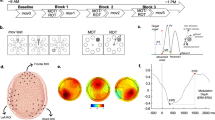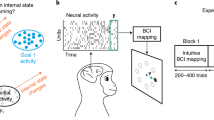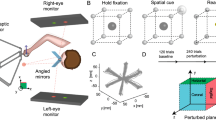Abstract
In the last few decades motor adaptation was extensively studied observing the invariant features of reaching movements. In a parallel neurobehavioral line of research emotional learning was studied under the umbrella of the ‘two-factor theory of learning’. In this study we explore the relation between motor learning and the autonomic response (heart rate, HR) of subjects performing point to point reaching movements holding a computer mouse. We consider two alternative outcomes: one is that autonomic response correlates with the learning rate and the second is that the autonomic response correlates with the residual error at the steady state. Eighteen subjects performed reaching movements under perturbed visual feedback demonstrating learning and after effects of learning. The hand movement as well as an Electrocardiogram signal were recorded throughout the training and carefully analyzed offline to extract the trial by trial error as well as the heart period. The results show clear correlation between the change in HR and the residual error but no correlation between the change in HR and the learning rate supporting the second alternative that the sensitivity to errors but not the learning rate correlates with the autonomic response. A control group of another seven subjects underwent the same experiment without the perturbed visual feedback. This control group showed no change in the HR. Further studies are required to validate this hypothesis and unravel the mechanism by which the autonomic response correlates with the residual motor error.







Similar content being viewed by others
References
Barlow JS (2002) The cerebellum and adaptive control. Cambridge University Press, Cambridge
Beggs WDA, Howarth CD (1970) Motor control in man in a repetitive motor task. Nature (London) 231:752–753
Bhushan N, Shadmehr R (1999) Computational nature of human adaptive control during learning of reaching movements in force fields. Biol Cybern 81:39–60
Davis M (1992) The role of the amygdala in conditioned fear. In: Aggleton JP (ed) The amygdala: neurobiological aspects of emotion, memory and mental dysfunction. Wiley-Liss, New York, pp 255–305
Donchin O, Francis JT, Shadmehr R (2003) Quantifying generalization from trial-by-trial behavior of adaptive systems that learn with basis functions: theory and experiments in human motor control. J Neurosci 23:9032–9045
Fairclough SH, Venables L, Tattersall A (2005) The influence of task demand and learning on the psychophysiological response. Int J Psychophysiol 56(2):171–184
Flash T, Gurevich I (1997) Models of motor adaptation and impedance control in human arm movements. In: Morasso P, Sanguineti V (eds) Self-organization, comutational maps, and motor control. Elsevier, Amsterdam, pp 423–481
Flash T, Hogan N (1985) The coordination of arm movements: an experimentally confirmed mathematical model. J Neurosci 5:1688–1703
Gallagher M, Graham PW, Holland PC (1990) The amygdala central nucleus and appetitive Pavlovian conditioning: lesions impair one class of conditioned behavior. J Neurosci 10:1906–1911
Gribble PL, Ostry DJ (2000) Compensation for loads during arm movements using equilibrium-point control. Exp Brain Res 135:474–482
Imamizu H, Kuroda T, Miyauchi S, Yoshioka T, Kawato M (2003) Modular organization of internal models of tools in the human cerebellum. Proc Natl Acad Sci USA 100:5461–5466
Inbar GF, Yafe A (1976) Parameter and signal adaptation in the stretch reflex loop. In: Homma S (ed) Progress in brain research, vol 44. Elsevier, Amsterdam, pp 317–337
Imamizu H, Miyauchi S, Tamada T, Sasaki Y, Takino R, Putz B, Yoshioka T, Kawato M (2000) Human cerebellar activity reflecting an acquired internal model of a new tool. Nature 403:192–195
Jordan MI (1996) Computational aspects of motor control and motor learning. In: Heuer H, Keele S (eds) Handbook of perception and action: motor skills. Academic Press, New York
Karniel A, Inbar GF (2000) Human motor control: learning to control a time-varying, nonlinear, many-to-one system. IEEE Trans Syst Man Cybern C Appl Rev 30:1–11
Karniel A, Mussa-Ivaldi FA (2003) Sequence, time, or state representation: how does the motor control system adapt to variable environments? Biol Cybern 89:10–21
Kawato M (1999) Internal models for motor control and trajectory planning. Curr Opin Neurobiol 9:718–727
Keele SW, Posner ML (1968) Processing of visual feedback in rapid movements. Psychology 77:155–158
Krakauer JW, Pine ZM, Chilardi M-F, Ghez C (2000) Learning visuomotor transformations for vectorial planning of reaching trajectories. J Neurosci 20:8916–8924
Krebs HI, Hogan N, Hening W, Adamovich SV, Poizner H (2001) Procedural motor learning in Parkinson’s disease. Exp Brain Res 141:425–437
Lackner JR, DiZio P (1994) Rapid adaptation to Coriolis force perturbations of arm trajectories. J Neurophysiol 72:299–313
LeDoux JE (1993) Emotional memory systems in the brain. Behav Brain Res 58:69–79
Lennartz RC, Weinberger NM (1992) Analysis of response systems in Pavlovian conditioning reveals rapidly versus slowly acquired conditioned-responses—support for 2 factors, implications for behavior and neurobiology. Psychobiology 20:93–119
Mihailoff GA, Kosinski RJ, Azizi SA, Border BG (1989) Survey of noncortical afferent projections to the basilar pontine nuclei: a retrograde tracing study in the rat. J Comp Neurol 282:617–643
Mintz M, Wang-Ninio Y (2001) Two-stage theory of conditioning: involvement of the cerebellum and the amygdala. Brain Res 897:150–156
Morasso P (1981) Spatial control of arm movements. Exp Brain Res 42:223–227
Neufeld M, Mintz M (2001) Involvement of the amygdala in classical conditioning of eyeblink response in the rat. Brain Res 889:112–117
Nijhof EJ (2003) On-line trajectory modifications of planar goal-directed arm movements. Human Movement. Science 22:13–36
Paillard J (1996) Fast and slow feedback loops for the visual correction of spatial errors in a pointing task: a reappraisal. Can J Physiol Pharmacol 74:401–417
Scheidt RA, Conditt MA, Secco EL, Mussa-Ivaldi FA (2005) Interaction of visual and proprioceptive feedback during adaptation of human reaching movements. J Neurophysiol 93:3200–3213
Scheidt RA, Dingwell JB, Mussa-Ivaldi FA (2001) Learning to move amid uncertainty. J Neurophysiol 86:971–985
Schweighofer N, Arbib MA, Kawato M (1998) Role of the cerebellum in reaching movements in humans. I. Distributed inverse dynamics control. Euro J Neurosci 10:86–94
Shadmehr R, Mussa-Ivaldi FA (1994) Adaptive representation of dynamics during learning of a motor task. J Neurosci 14:3208–3224
Shadmehr R, Wise SP (2005) The computational neurobiology of reaching and pointing: a foundation for motor learning. MIT Press, Cambridge
Smith MA, Ghazizadeh A, Shadmehr R (2006) Interacting adaptive processes with different timescales underlie short-term motor learning. Plos Biol 4:1035–1043
Thoroughman KA, Shadmehr R (2000) Learning of action through adaptive combination of motor primitives. Nature 407:742–747
Thoroughman KA, Taylor JA (2005) Rapid reshaping of human motor generalization. J Neurosci 25:8948–8953
Wang JS, Sainburg RL (2004) Limitations in interlimb transfer of visuomotor rotations. Exp Brain Res 155:1–8
Weisz DJ, Harden DG, Xiang Z (1992) Effects of amygdala lesions on reflex facilitatin and conditioned response acquisition during nictitating membrane response conditioning in rabbit. Behav Neurosci 106:262–273
Wolpert DM, Ghahramani Z (2000) Computational principles of movement neuroscience. Nat Neurosci Suppl 3:1212–1217
Wolpert DM, Ghahramani Z, Jordan MI (1995) Are arm trajectories planned in kinematic or dynamic coordinates—an adaptation study. Exp Brain Res 103:460–470
Wolpert DM, Miall RC, Kawato M (1998) Internal models in the cerebellum. Trends Cogn Sci 2:338–347
Author information
Authors and Affiliations
Corresponding author
Appendix
Appendix
Linearization of cursor versus mouse velocity
The position of the cursor on the monitor served to define the position of the mouse/hand on the board. However, as occurs with standard computer mouse, the transformation between the velocity of the hand/mouse on-board \( \left( {\overrightarrow {V}_{h} } \right) \) and the on-screen cursor velocity \( \left( {\overrightarrow {V}_{c} } \right) \) is not linear. In addition, the on-screen curser speed had been set to slow speed (The new mouse speed was set to ‘1’ through ‘windows’ SPI_SETMOUSESPEED function) to force wide hand movements by the subjects. In an ad hoc calibration test of the practical hand movement range of V h = 0–120 cm/s we observed a fine fit to simple quadratic relationship between cursor velocity and hand velocity as presented by Eq. 14. Precise analysis of hand velocity according to the recorded original cursor velocity, should consider the inverse transformation assuming that there was no distortion in the angle of the velocity vector.
Considering only the positive solution one can solve for the inverse transformation as follows:
This corrective action was done off-line to approximate the original mouse/hand movements. No linearization correction was implemented on-line, thus keeping the nonlinearity of the velocity transformation, as in a standard mouse cursor behavior, during the game. Figure 8 presents the planar trajectories and velocities of the cursor and the hand/mouse motion, during two typical no-perturbation trials movements (R → L and L → R). The cursor velocity recordings served to calculate the hand/mouse velocity by applying the inverse transformation described by Eq. 15. In addition, assuming no distortion in the angle of the cursor velocity vector in respect to the angle of the hand velocity vector, the Cartesian vectors of \( \overrightarrow {V}_{h} \) were calculated (i.e., V hx and V hy ). Since the sampling rate of the cursor position was constant, the Cartesian coordinates of the hand/mouse position (i.e., X h & Y h ) can be calculated according to Eq. 16.
Although there is a quite difference between the velocity of the cursor and the velocity of the hand/mouse motion, their path are rather similar (straight line) and their velocity profiles are bell shaped. Due to the similarity in the path we assume that the cursor location and deviation from straight line represents the hand’s deviation from a straight line.
Rights and permissions
About this article
Cite this article
Edrei, Y., Mintz, M., Barnea, O. et al. Involvement of the autonomic nervous system in motor adaptation: acceleration or error reduction?. Exp Brain Res 192, 133–143 (2009). https://doi.org/10.1007/s00221-008-1565-8
Received:
Accepted:
Published:
Issue Date:
DOI: https://doi.org/10.1007/s00221-008-1565-8





